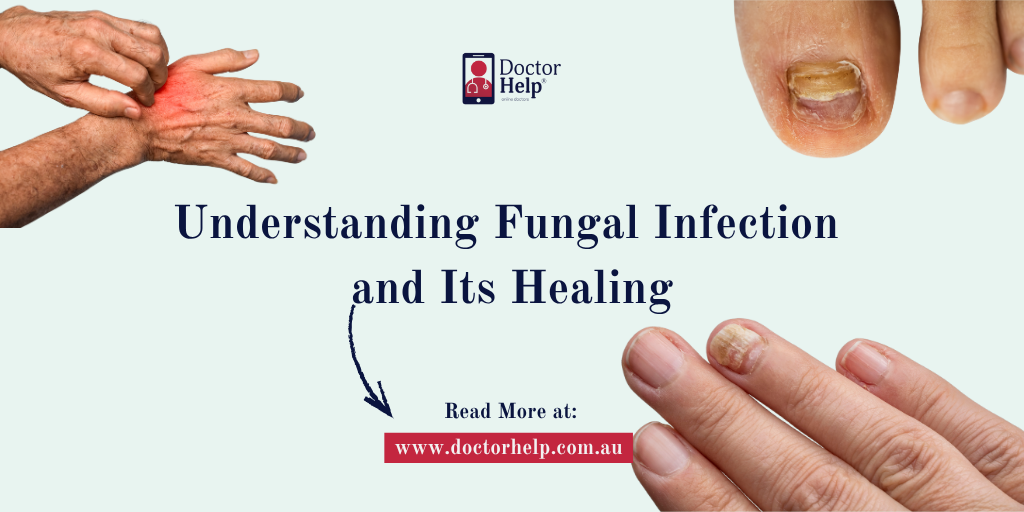Table of Contents
Sometimes, our skin has a way of speaking up before we do. A silent itch, which develops into a burn, a spot which begins to speak to us, then gradually we realize that we are regarding the mirror and wondering what is happening.
And that is you just now? Breathe. You’re not alone.
The presence of a fungal infection is not an indicator of bad habits and poor hygiene. It is just life being life, a combination of dampness, warmth and time which allows some of those nasty fungi to get themselves a little too cozy. In Australia, with our hot summers and endless beach days, this is more common than most of us realise. Millions of people get infected with fungi each year through minor rashes and ones requiring medical attention.
So, let’s get further into the details.
The Hidden Life of a Fungal Infection
Think of fungi as the quiet tenants living on your skin. Mostly they act like just elements of the natural ecosystem of your skin. However, they outlive their welcome when things become hot, humid or unbalanced. It is then that you realize it, the itch, the flake, the red wreath of irritation, which will not retreat.
Doctors refer to it as mycosis or any infection by fungi. Some stay on the surface, others can sneak a bit deeper if ignored. But here’s the thing: almost all can be treated and healed with a bit of care and consistency.
Spotting the Signs Before They Spread
Every fungal infection has its own personality. Some are loud and dramatic, others sneak in quietly. Common signs include:
- Itchy or burning skin that worsens with sweat
- Red, scaly or cracked patches
- White or discoloured spots that stand out against your normal tone
- Nails turning brittle or thick
- Peeling between toes or around moist folds
Sometimes, untreated infections can invite bacteria in, leading to complications like cellulitis and that requires proper cellulitis treatment from your doctor. It’s always better to act early than to wait it out.
Causes of Fungal Infection
A fungal infection can start for the simplest reasons. Maybe it’s staying in damp gym clothes after a workout, or long beach days where you forget to dry off completely. Sometimes, it’s not about what you did but what your skin went through.
Here’s what commonly sets it off:
- Excess sweat and humidity (hello, Aussie summers)
- Tight or synthetic fabrics that trap moisture
- Sharing towels or footwear
- A weakened immune system
- Even a small unnoticed cut that opens the door to fungi
Our skin is resilient, but it also remembers. Once that balance is thrown off, fungi take it as an invitation.
The Different Faces of Fungal Infection
Tinea (Ringworm)
Despite the name, there’s no worm involved. Tinea is a group of fungal infections that form ring-shaped patches like red, raised, and sometimes scaly. Whether it shows up on your feet as an athlete’s foot or in the groin area as jock itch, it’s the same mischievous culprit.
Tinea Versicolor
This one is less obvious but no less exasperating. Small patches of lighter or darker skin appear, often on the chest or back, refusing to tan like the rest. Tinea versicolor can be found in hot humid air and it is not harmful but leaves one with self-esteem issues.
Yeast Infections (Candidiasis)
These infections tend to blossom in places whereby the skin comes into contact with skin. Itchy, red, and sore, they are caused by the candida yeast. Under normal circumstances, the candida yeast lives in harmony on our skin until the scales are tipped.
Nail Fungal Infections (Onychomycosis)
Slow, unresponsive and even embarrassing, nail infections lead to thickening of nails, yellowing of nails or crumbling. They take patience to heal but can absolutely be treated.
Finding the Right Treatment
The good news? You’re not stuck with it. Fungus is one of the easiest skin conditions to treat when you are aware of the type of infection you have.
Over-the-counter antifungal cream suffices in the case of mild cases. Apply it regularly, keep the area clean and dry, and give it time since fungi hate persistence. In case the infection still persists, then your physician may order oral antifungal medication to treat deeper or more severe infections.
It is also necessary to wash the socks and footwear correctly and not to share the personal stuff to avoid reinfection.
Consistency matters. Continue treatment of the area even when your symptoms start to improve as fungi are known to recur once you discontinue treatment too early.
Natural Ways to Support Healing
While antifungal treatments are your main weapon, small lifestyle tweaks can speed up healing and reduce flare-ups.
Try these simple changes:
- Choose breathable fabrics and loose clothing
- Change out of wet clothes as soon as you can
- Use gentle cleansers instead of harsh soaps
- Keep skin folds dry and aired out
- Support your immune system through good sleep and nutrition
Fungi are the foe of a clean and dry environment. And sometimes, that’s half the battle won.
Read: A Detailed Guide To Common Skin Conditions And Available Treatments
When to Call in the Professionals
When you have used an antifungal cream with no effect over a period of two weeks or when the infection recurs again, then it is time to visit your GP. Certain fungal infections can resemble eczema or psoriasis and something that appears to be one may actually be the other.
The right diagnosis will save you weeks of frustration as you will be treating the right disorder.
The Deeper Truth About Skin and Healing
There’s something humbling about dealing with a skin infection. It’s so visible, so intimate. It is impossible to conceal, and it makes you aware of the way we are all linked to our bodies: how much attention they are requesting so silently.
Fungal infections may test your patience, but they also invite gentleness. They ask you to slow down, to listen. To care for yourself not just with creams and medicine, but with presence and patience.
Healing isn’t always quick, but it’s always possible.
In case your skin has been screaming to get your attention and you have been sweeping it away, then perhaps it is time to hear it out today. You do not need to determine it on your own anymore, our telehealth physicians can help you through it with care
Book your telehealth consultation today and give your skin the kindness it’s been waiting for. Because sometimes, healing starts with being heard.
References:
- Fungal infections (Mycosis). (2025, June 2). Cleveland Clinic.
https://my.clevelandclinic.org/health/diseases/24401-fungal-infections-mycosis - Healthdirect Australia. (n.d.-a). Tinea. Symptoms, Types & Treatment | Healthdirect.
https://www.healthdirect.gov.au/tinea - Healthdirect Australia. (n.d.-b). Toenail infection. Healthdirect.
https://www.healthdirect.gov.au/toenail-infection - Tinea versicolor – Symptoms & causes – Mayo Clinic. (2025, August 11). Mayo Clinic.
https://www.mayoclinic.org/diseases-conditions/tinea-versicolor/symptoms-causes/syc-20378385













